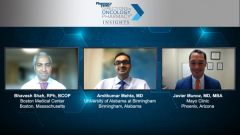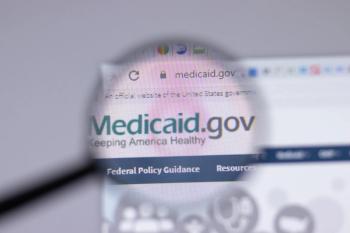
Understanding Second-Line Treatment Options for MZL
Following discussion on the NCCN guidelines for second-line therapy in marginal zone lymphoma, experts highlight approved treatment options.
Episodes in this series

Transcript:
Bhavesh Shah, RPh, BCOP: We talked about some of the general treatments that we have for these patients. Looking at the NCCN [National Comprehensive Cancer Network] guidelines, which everybody uses, a lot of the treatments have impact on payer coverage. They have impact on level of evidence and practice. I know of institutions that directly take the NCCN guidelines and put them into their electronic medical record. Javier, can you comment on some of the regimens from the NCCN guidelines that are utilized for this disease?
Javier Munoz, MD, MBA: Absolutely. The NCCN guidelines aren’t gospel, but they’re extremely helpful in validating some of these therapies. To recommend the second-line therapy, we first need to know what first-line therapy was chosen. Amit has already discussed first-line therapy in a very eloquent and elegant fashion, including the BRIGHT study. He alluded to bendamustine plus rituximab. The caveats have already been mentioned. We tend to lump together multiple indolent lymphomas in the same bucket. The BRIGHT study included follicular lymphoma, marginal zone lymphoma, and even mantle cell lymphoma, which most of us consider an aggressive lymphoma and not an indolent one. Only 46 patients had marginal zone lymphoma in the BRIGHT study. It was certainly enriched with follicular lymphoma, with 300-plus patients. And rightfully so, because follicular lymphoma is the most common indolent lymphoma. In theory, the same options that we had available in the first line could potentially be available in the second line if they haven’t been used previously.
If you go to NCCN guidelines, you’ll find bendamustine plus rituximab, bendamustine plus obinutuzumab, R-CVP [rituximab, cyclophosphamide, vincristine, prednisone], R-CHOP [rituximab, cyclophosphamide, doxorubicin, vincristine, prednisone], and R-squared, which is lenalidomide plus rituximab. You’ll find BTK [Bruton tyrosine kinase] inhibitors, like ibrutinib and the recently FDA-approved zanubrutinib. We even have the PI3 kinase inhibitors. We have 4 in the market: idelalisib, copanlisib, duvelisib, and umbralisib. We have a plethora of options, which is a good problem to have. How do we choose? It depends on the first-line therapy, the duration of response to that first-line therapy, performance status, comorbidities, patient preference, and age. I personally look for excuses not to prescribe chemotherapy, so I’m grateful to have nonchemotherapy options in the second line.
Bhavesh Shah, RPh, BCOP: We have so many options. It depends on which first-line agent was used. We know that most of those patients will be getting a B-cell depletion therapy. Amit, how do you approach a patient who’s gotten rituximab in the first line and now requires second-line therapy? What’s your next approach?
Amitkumar Mehta, MD: That’s a great question. As Javier mentioned, with multiple options, you scratch your head and wonder, what would I pick? It depends on disease characteristics, patient characteristics, and patient preference. Most of the time, it’s a discussion with the patients, and you decide based on the discussion. You can make a recommendation, and then the patient can chip in and say, “This is what I would prefer,” when you discuss the data. I want to emphasize that because it’s a low-grade lymphoma, second-line therapy also follows the same indications as first-line therapy. I always tell my patients that if you do a scan and see small lymph nodes here and there, but otherwise you’re doing excellent, with normal activities, no low blood counts, no effusions, no bulky lymph nodes, then continue to follow the same guidelines. That means you don’t need a treatment at this time. As I mentioned, active surveillance is the key. I educate my patients about the symptoms, so if they experience them, they call me and I get the scans and pursue from there.
The other point I also want to emphasize is that if they develop symptoms, I do a scan, and I see the lymph nodes, I make sure that I do a PET [positron emission tomography] scan, because I want to see the activity of that lymph node. I want to make sure it’s not a transformed lymphoma. Transformation means it converted from low-grade to high-grade lymphoma. That rarely happens, but it does happen. You must rule that out before you make a final decision for the treatment. Once you are at that junction and have ruled out transformation, the patient has progressed, and there are symptoms where you’re considering treatment, that’s when you jump on and discuss the various treatment options.
For most of the centers, with the NCCN guidelines, the first preference could be clinical trials. If they’re available, we offer clinical trials to our patients. That’s very standard. As Javier mentioned, he has a CAR [chimeric antigen receptor] T-cell therapy clinical trial. That’s where our patients look to see if there are better agents. If they’re not eligible for trial, or trials aren’t available, that’s when you open the second-line therapy box. The first-line therapy is critical. You decide on second-line therapy based on what kind of first-line therapy they got. Also, with the pandemic, oftentimes the patients ask whether we have oral therapy options, compared with infusion. As Javier mentioned, oftentimes patients say, “I don’t want to go through chemotherapy. I want to have smarter agents.”
The approved agents in the nonchemotherapy setting mainly fall into 3 buckets, one of which being BTK inhibitors. We have 2 BTK inhibitors approved. One is ibrutinib, which is a first-generation BTK inhibitor. We also have zanubrutinib, which is a second-generation BTK inhibitor, more specific, and has less impact on other kinases, like TEC and EGFR. Therefore, we see fewer adverse effects, like atrial fibrillation, bleeding, and bruising. The second bucket is IMiDs [immunomodulatory drugs], especially lenalidomide, which is also approved in that setting, or being used in the marginal zone lymphoma setting, especially in combination with rituximab or CD20-directed therapy. The third bucket is the PI3 kinase inhibitor. As Javier mentioned, there are 4 right now. But in marginal zone lymphoma, only 1 is approved: umbralisib. The other 3 have shown activity, but aren’t formally approved in that setting. You could use it off-label, but umbralisib is the one that was recently approved in marginal zone lymphoma.
Bhavesh Shah, RPh, BCOP: Thank you for sharing that. As a pharmacist, I’m always thinking about cost as well. We forget about those decisions. Clinically, if there’s equivalence, then we have to look at cost, too. Now we have rituximab biosimilars and the obinutuzumab combination. Is there superiority with an obinutuzumab-based regimen vs a rituximab-based regimen from your perspective? Because obviously there’s a pretty big cost difference.
Amitkumar Mehta, MD: Yes. Obinutuzumab has been explored in the relapsed setting as well as in the frontline setting. I don’t think the frontline data are convincing enough that I’d change my practice to use obinutuzumab in marginal zone lymphoma in the frontline setting. In the relapsed setting, there’s definitely benefit of using obinutuzumab, especially in rituximab-refractory cases where there’s progression within 6 months. It comes with more adverse effects, especially cytopenia and infections, so that’s something that you weigh if you want to use obinutuzumab in place of rituximab.
When you talk about cost, everything is costly in oncology. The bigger discussion all across is whether we have an end point to any treatment compared with continuous treatment. That’s what the patients mainly look for. If I start them on a pill, the next question they’re going to ask me is, “When can I stop?” In chemotherapy, they have the mindset of, “I’m going to get 6 cycles, and I’m going to stop.” But in oral therapies, we typically say there are 2 end points: if you can’t handle the drug or if your cancer grows over it, then we’ll stop it.
Transcript edited for clarity.
Newsletter
Stay informed on drug updates, treatment guidelines, and pharmacy practice trends—subscribe to Pharmacy Times for weekly clinical insights.


















































































































































































































